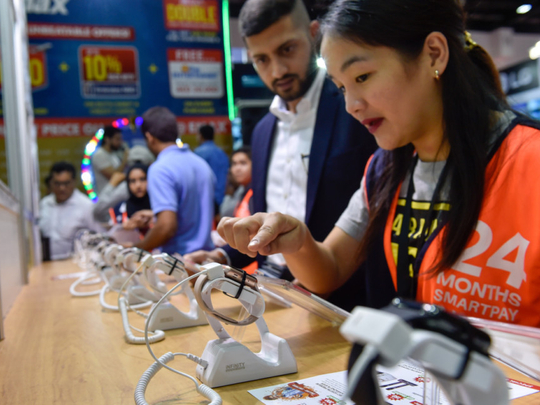
Dubai: Retailers are seeing a renewed surge in demand for smartwatches with the new launches from Apple and Samsung.
Nilesh Khalkho, CEO of Sharaf DG, said that wearables are a growth category and are becoming mainstream.
“People not only want to buy wearables for health but it also becoming an accessory for a smartphone. Apple is definitely registering more growth, followed by Fitbit and Samsung,” he said.
Ayse Kaptanoglu, senior research analyst at market research firm International Data Corporation (IDC), said the launch of LTE supported products by Apple will have a positive impact on the consumer market. “Consumers will prefer to purchase LTE-supported watches since the functionality will be increased by just paying $20-$30 more. So the smartwatches will not be only accessories for consumers but also their essential electronic devices such as mobile phones,” she said.
Samsung doesn’t have approval for LTE yet, so, she said that this will decrease the demand even though they launched flagship product recently.
Apple eSIM watches will definitely gain more traction; she said and added that it will not be surprising if Apple Watches are expected to become the second best-selling electronic device after smartphones.
An eSIM is a digital SIM that allows users to activate a cellular plan from a carrier without having to use a physical SIM.
The SIM card on a phone allows a mobile operator to identify and authenticate a consumer, which in turn gives the consumer access to the mobile network to for calls and data.
According to the analyst, the wearables market in UAE, including basic and smart wearables, is projected to grow 2.4 per cent quarter on quarter and 5.2 per cent year on year in volume to 137,147 units in the third quarter of this year.
Smart wearables are devices that run third-party applications, while basic refers to those that can only perform specific functions and do not support third-party apps.
Kaptanoglu said that smartwatches are expected to have 40.2 per cent annual growth, on the other hand, basic wearables will have 16 per cent year-on-year decline.
“The wearables market is still evolving, with new vendors from the technology and non-technology fields are entering into the wearables space. In terms of the utility of wearables, health and fitness have been a key focus area but now fashion has also become a key selling point,” she said.
Moreover, she said that basic wearables are slowing down as users are transitioning to smart wearables that can run third-party applications.
“But these [basic wearables] are still selling thanks to Chinese brands and retailer’s promotion with bundling. Connectivity and eSIM features with new product launches are all drivers of smart wearables market. From a total volume perspective, basic wearables will account almost same shipment volumes with smart ones in the second quarter but in later quarters, smartwatches will be showing higher growth,” she said.
However, she said that the usage of third-party apps in wearables is limited for now.
“There is little focus on developing new applications or making use of the existing data captured by wearables. In the short term it is expected that the third-party apps will play a critical role in improving the performance of wearables,” she said.













